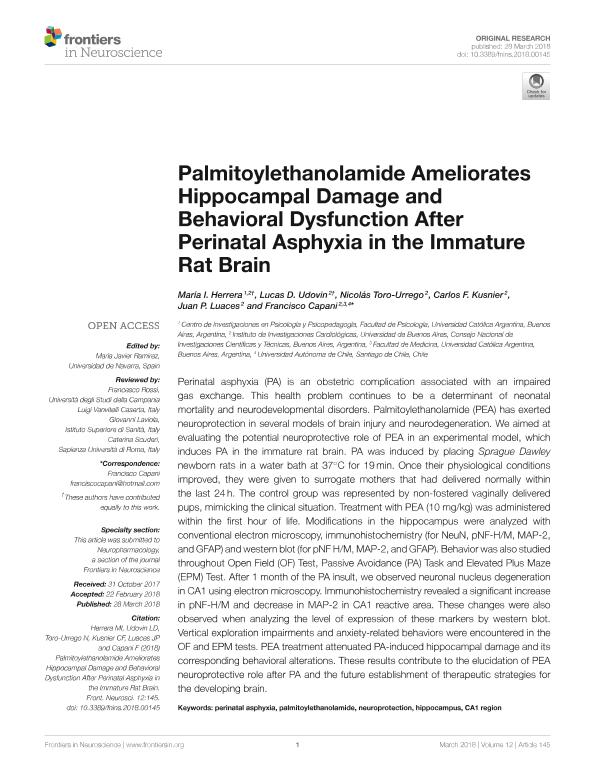Artículo
Palmitoylethanolamide ameliorates hippocampal damage and behavioral dysfunction after perinatal asphyxia in the immature rat brain
Herrera, María Inés ; Udovin, Lucas
; Udovin, Lucas ; Toro Urrego, Nicolas
; Toro Urrego, Nicolas ; Kusnier, Carlos Federico
; Kusnier, Carlos Federico ; Luaces, Juan Pablo
; Luaces, Juan Pablo ; Capani, Francisco
; Capani, Francisco
 ; Udovin, Lucas
; Udovin, Lucas ; Toro Urrego, Nicolas
; Toro Urrego, Nicolas ; Kusnier, Carlos Federico
; Kusnier, Carlos Federico ; Luaces, Juan Pablo
; Luaces, Juan Pablo ; Capani, Francisco
; Capani, Francisco
Fecha de publicación:
03/2018
Editorial:
Frontiers Media S.A.
Revista:
Frontiers in Neuroscience
ISSN:
1662-4548
e-ISSN:
1662-453X
Idioma:
Inglés
Tipo de recurso:
Artículo publicado
Clasificación temática:
Resumen
Perinatal asphyxia (PA) is an obstetric complication associated with an impaired gas exchange. This health problem continues to be a determinant of neonatal mortality and neurodevelopmental disorders. Palmitoylethanolamide (PEA) has exerted neuroprotection in several models of brain injury and neurodegeneration. We aimed at evaluating the potential neuroprotective role of PEA in an experimental model, which induces PA in the immature rat brain. PA was induced by placing Sprague Dawley newborn rats in a water bath at 37°C for 19 min. Once their physiological conditions improved, they were given to surrogate mothers that had delivered normally within the last 24 h. The control group was represented by non-fostered vaginally delivered pups, mimicking the clinical situation. Treatment with PEA (10 mg/kg) was administered within the first hour of life. Modifications in the hippocampus were analyzed with conventional electron microscopy, immunohistochemistry (for NeuN, pNF-H/M, MAP-2, and GFAP) and western blot (for pNF H/M, MAP-2, and GFAP). Behavior was also studied throughout Open Field (OF) Test, Passive Avoidance (PA) Task and Elevated Plus Maze (EPM) Test. After 1 month of the PA insult, we observed neuronal nucleus degeneration in CA1 using electron microscopy. Immunohistochemistry revealed a significant increase in pNF-H/M and decrease in MAP-2 in CA1 reactive area. These changes were also observed when analyzing the level of expression of these markers by western blot. Vertical exploration impairments and anxiety-related behaviors were encountered in the OF and EPM tests. PEA treatment attenuated PA-induced hippocampal damage and its corresponding behavioral alterations. These results contribute to the elucidation of PEA neuroprotective role after PA and the future establishment of therapeutic strategies for the developing brain.
Archivos asociados
Licencia
Identificadores
Colecciones
Articulos(ININCA)
Articulos de INST.DE INVEST.CARDIOLOGICAS (I)
Articulos de INST.DE INVEST.CARDIOLOGICAS (I)
Articulos(SEDE CENTRAL)
Articulos de SEDE CENTRAL
Articulos de SEDE CENTRAL
Citación
Herrera, María Inés; Udovin, Lucas; Toro Urrego, Nicolas; Kusnier, Carlos Federico; Luaces, Juan Pablo; et al.; Palmitoylethanolamide ameliorates hippocampal damage and behavioral dysfunction after perinatal asphyxia in the immature rat brain; Frontiers Media S.A.; Frontiers in Neuroscience; 12; MAR; 3-2018; 1-13
Compartir
Altmétricas



